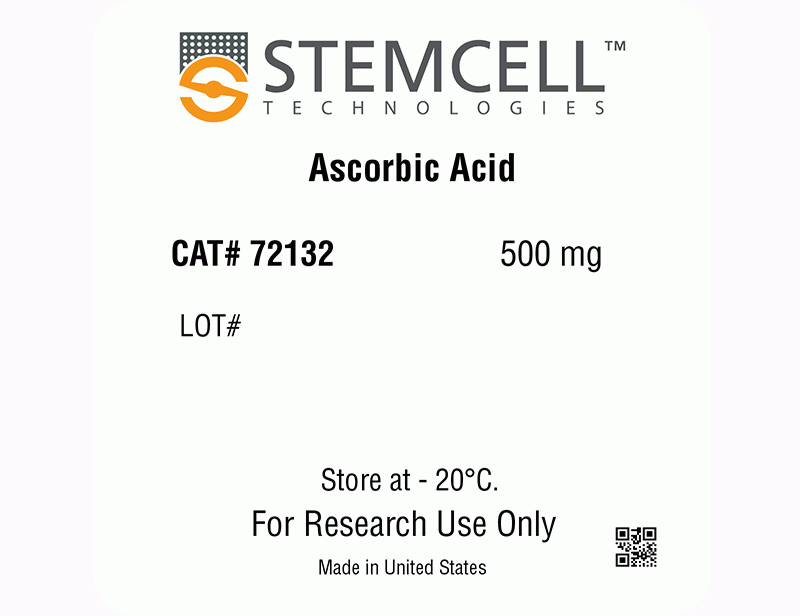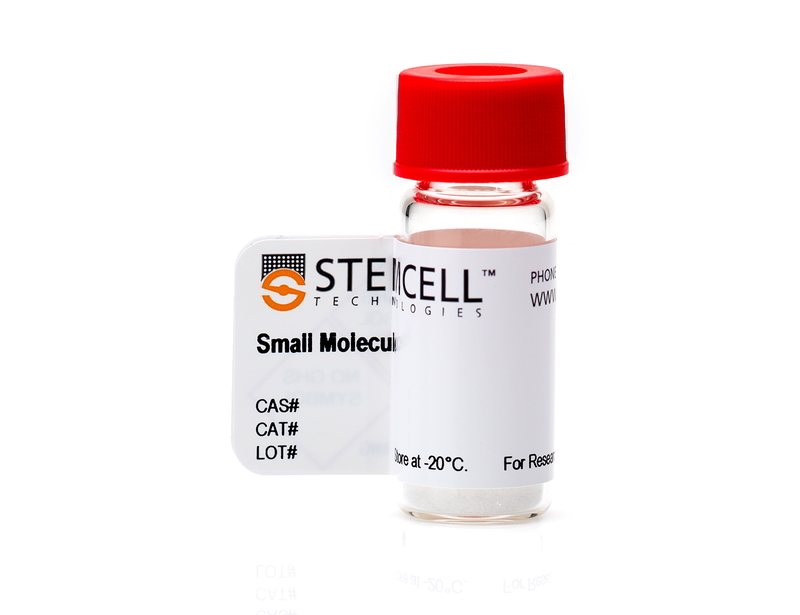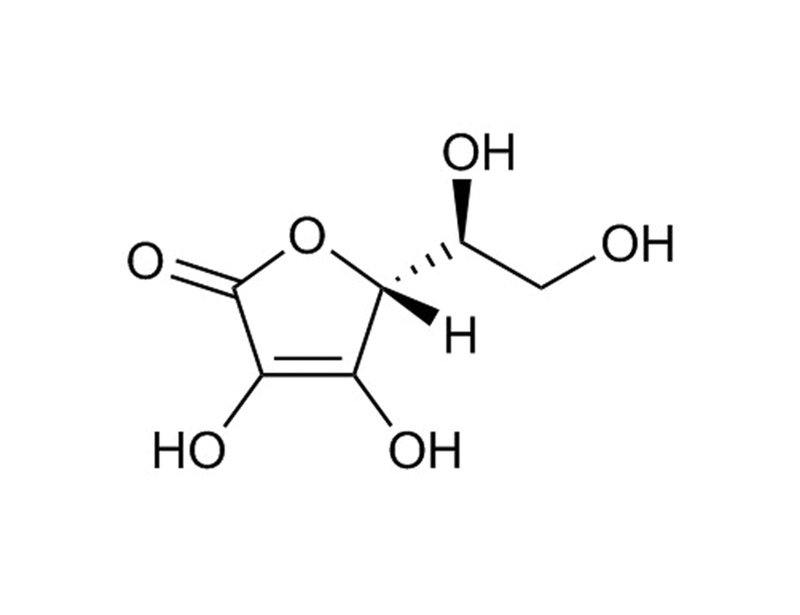概要
Ascorbic Acid is a naturally occurring lactone that is produced by plants and many animals, but not humans or other primates. It acts as an electron donor (i.e. reducing agent), and shows antioxidant activity, particularly against reactive oxygen species. Ascorbic Acid is a cofactor for monooxygenase and dioxygenase as well as other enzymes (Arrigoni & De Tullio; Du et al.).
REPROGRAMMING
· Increases the efficiency of reprogramming mouse and human fibroblasts to induced pluripotent stem (iPS) cells (Esteban et al.) partly through JHDM1 histone demethylase activity (Wang et al.).
· Prevents aberrant DNA methylation of the Dlk1-Dio3 locus during reprogramming of mouse somatic cells to iPS cells (Stadtfeld et al.).
MAINTENANCE AND SELF-RENEWAL
· Supports proliferation of mesenchymal stem cells (Choi et al.).
DIFFERENTIATION
· Promotes differentiation of osteoblasts from human and mouse mesenchymal cells (Pittenger et al.; Tropel et al.).
· Promotes differentiation of osteoblasts from mouse embryonic stem (ES) cells (zur Nieden et al.).
· Enhances differentiation of cardiomyocytes from mouse ES cells (Takahashi et al.).
REPROGRAMMING
· Increases the efficiency of reprogramming mouse and human fibroblasts to induced pluripotent stem (iPS) cells (Esteban et al.) partly through JHDM1 histone demethylase activity (Wang et al.).
· Prevents aberrant DNA methylation of the Dlk1-Dio3 locus during reprogramming of mouse somatic cells to iPS cells (Stadtfeld et al.).
MAINTENANCE AND SELF-RENEWAL
· Supports proliferation of mesenchymal stem cells (Choi et al.).
DIFFERENTIATION
· Promotes differentiation of osteoblasts from human and mouse mesenchymal cells (Pittenger et al.; Tropel et al.).
· Promotes differentiation of osteoblasts from mouse embryonic stem (ES) cells (zur Nieden et al.).
· Enhances differentiation of cardiomyocytes from mouse ES cells (Takahashi et al.).
技术资料
| Document Type | 产品名称 | Catalog # | Lot # | 语言 |
|---|---|---|---|---|
| Product Information Sheet | Ascorbic Acid | 72132 | All | English |
| Safety Data Sheet | Ascorbic Acid | 72132 | All | English |
数据及文献
Publications (10)
Biochimica et biophysica acta 2012 DEC
Ascorbic acid: chemistry, biology and the treatment of cancer.
Abstract
Abstract
Since the discovery of vitamin C, the number of its known biological functions is continually expanding. Both the names ascorbic acid and vitamin C reflect its antiscorbutic properties due to its role in the synthesis of collagen in connective tissues. Ascorbate acts as an electron-donor keeping iron in the ferrous state thereby maintaining the full activity of collagen hydroxylases; parallel reactions with a variety of dioxygenases affect the expression of a wide array of genes, for example via the HIF system, as well as via the epigenetic landscape of cells and tissues. In fact, all known physiological and biochemical functions of ascorbate are due to its action as an electron donor. The ability to donate one or two electrons makes AscH(-) an excellent reducing agent and antioxidant. Ascorbate readily undergoes pH-dependent autoxidation producing hydrogen peroxide (H(2)O(2)). In the presence of catalytic metals this oxidation is accelerated. In this review, we show that the chemical and biochemical nature of ascorbate contribute to its antioxidant as well as its prooxidant properties. Recent pharmacokinetic data indicate that intravenous (i.v.) administration of ascorbate bypasses the tight control of the gut producing highly elevated plasma levels; ascorbate at very high levels can act as prodrug to deliver a significant flux of H(2)O(2) to tumors. This new knowledge has rekindled interest and spurred new research into the clinical potential of pharmacological ascorbate. Knowledge and understanding of the mechanisms of action of pharmacological ascorbate bring a rationale to its use to treat disease especially the use of i.v. delivery of pharmacological ascorbate as an adjuvant in the treatment of cancer.
Nature genetics 2012 APR
Ascorbic acid prevents loss of Dlk1-Dio3 imprinting and facilitates generation of all-iPS cell mice from terminally differentiated B cells.
Abstract
Abstract
The generation of induced pluripotent stem cells (iPSCs) often results in aberrant epigenetic silencing of the imprinted Dlk1-Dio3 gene cluster, compromising the ability to generate entirely iPSC-derived adult mice ('all-iPSC mice'). Here, we show that reprogramming in the presence of ascorbic acid attenuates hypermethylation of Dlk1-Dio3 by enabling a chromatin configuration that interferes with binding of the de novo DNA methyltransferase Dnmt3a. This approach allowed us to generate all-iPSC mice from mature B cells, which have until now failed to support the development of exclusively iPSC-derived postnatal animals. Our data show that transcription factor-mediated reprogramming can endow a defined, terminally differentiated cell type with a developmental potential equivalent to that of embryonic stem cells. More generally, these findings indicate that culture conditions during cellular reprogramming can strongly influence the epigenetic and biological properties of the resultant iPSCs.
Cell stem cell 2011 DEC
The histone demethylases Jhdm1a/1b enhance somatic cell reprogramming in a vitamin-C-dependent manner.
Abstract
Abstract
Reprogramming of somatic cells into induced pluripotent stem cells (iPSCs) resets the epigenome to an embryonic-like state. Vitamin C enhances the reprogramming process, but the underlying mechanisms are unclear. Here we show that the histone demethylases Jhdm1a/1b are key effectors of somatic cell reprogramming downstream of vitamin C. We first observed that vitamin C induces H3K36me2/3 demethylation in mouse embryonic fibroblasts in culture and during reprogramming. We then identified Jhdm1a/1b, two known vitamin-C-dependent H3K36 demethylases, as potent regulators of reprogramming through gain- and loss-of-function approaches. Furthermore, we found that Jhdm1b accelerates cell cycle progression and suppresses cell senescence during reprogramming by repressing the Ink4/Arf locus. Jhdm1b also cooperates with Oct4 to activate the microRNA cluster 302/367, an integral component of the pluripotency machinery. Our results therefore reveal a role for H3K36me2/3 in cell fate determination and establish a link between histone demethylases and vitamin-C-induced reprogramming.
Cell stem cell 2010 JAN
Vitamin C enhances the generation of mouse and human induced pluripotent stem cells.
Abstract
Abstract
Somatic cells can be reprogrammed into induced pluripotent stem cells (iPSCs) by defined factors. However, the low efficiency and slow kinetics of the reprogramming process have hampered progress with this technology. Here we report that a natural compound, vitamin C (Vc), enhances iPSC generation from both mouse and human somatic cells. Vc acts at least in part by alleviating cell senescence, a recently identified roadblock for reprogramming. In addition, Vc accelerates gene expression changes and promotes the transition of pre-iPSC colonies to a fully reprogrammed state. Our results therefore highlight a straightforward method for improving the speed and efficiency of iPSC generation and provide additional insights into the mechanistic basis of the reprogramming process.
Journal of bioscience and bioengineering 2008 JUN
Effect of ascorbic acid on bone marrow-derived mesenchymal stem cell proliferation and differentiation.
Abstract
Abstract
Mesenchymal stem cells (MSCs) derived from bone marrow are an important tool in tissue engineering and cell-based therapies because of their multipotent capacity. Majority of studies on MSCs have investigated the roles of growth factors, cytokines, and hormones. Antioxidants such as ascorbic acid can be used to expand MSCs while preserving their differentiation ability. Moreover, ascorbic acid can also stimulate MSC proliferation without reciprocal loss of phenotype and differentiation potency. In this study, we evaluated the effects of ascorbic acid on the proliferation, differentiation, extracellular matrix (ECM) secretion of MSCs. The MSCs were cultured in media containing various concentrations (0-500 microM) of L-ascorbate-2-phosphate (Asc-2-P) for 2 weeks, following which they were differentiated into adipocytes and osteoblasts. Ascorbic acid stimulated ECM secretion (collagen and glycosaminoglycan) and cell proliferation. Moreover, the phenotypes of the experimental groups as well as the differentiation potential of MSCs remained unchanged. The apparent absence of decreased cell density or morphologic change is consistent with the toxicity observed with 5-250 microM concentrations of Asc-2-P. The results demonstrate that MSC proliferation or differentiation depends on ascorbic acid concentration.
Experimental cell research 2004 MAY
Isolation and characterisation of mesenchymal stem cells from adult mouse bone marrow.
Abstract
Abstract
The future use of adult mesenchymal stem cells (MSCs) for human therapies depends on the establishment of preclinical studies with other mammals such as mouse. Surprisingly, purification and characterisation of murine MSCs were only poorly documented. The aim of this study was to purify mouse MSCs from adult bone marrow and to functionally characterise their abilities to differentiate along diverse lineages. Adherent cells from adult C57Bl/6J mouse bone marrow were depleted of granulo-monocytic cells and subsequently allowed to grow on fibronectin-coated dishes in presence of fetal bovine serum and growth factors. The growing fibroblastoid cell population primarily consisted of spindle- and star-shaped cells with significant renewal capacity as they were cultured until 30 passages (about 60 doubling population). We fully demonstrated the MSC phenotype of these cells by inducing them to differentiate along osteoblastic, adipocytic, and chondrocytic pathways. Mouse MSCs (mMSCs) sharing the same morphological and functional characteristics as human MSCs can be successfully isolated from adult bone marrow without previous mouse or bone marrow treatment. Therefore, mMSCs will be an important tool to study the in vivo behaviour and fate of this cell type after grafting in mouse pathology models.

 网站首页
网站首页




